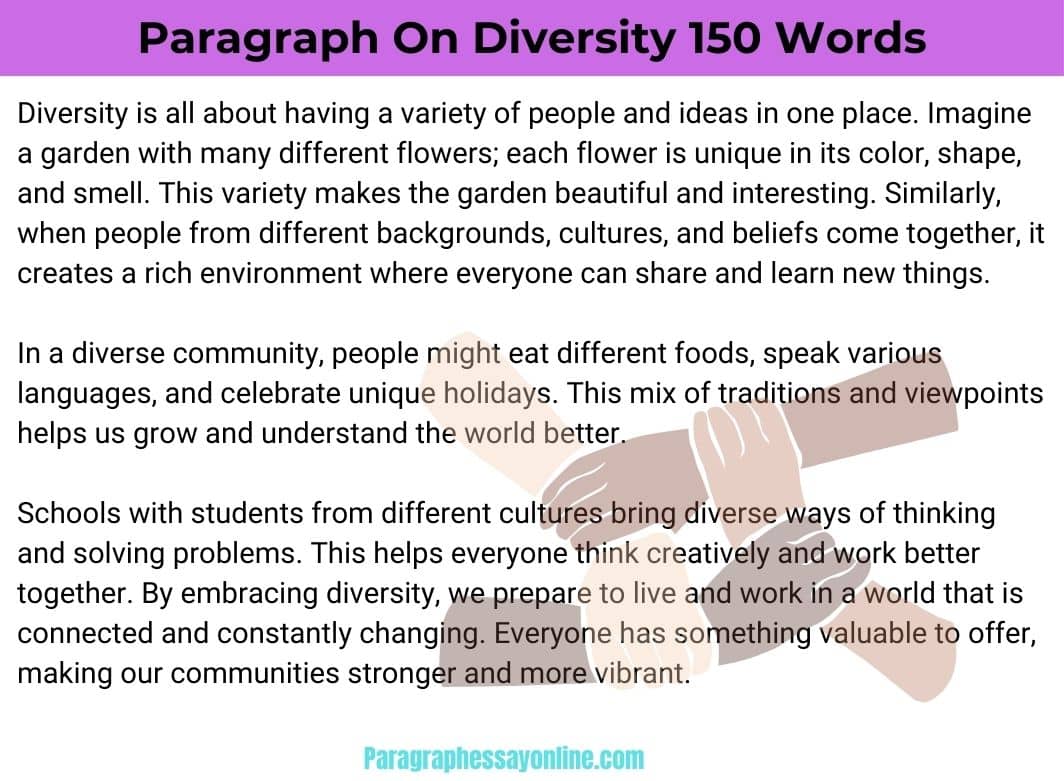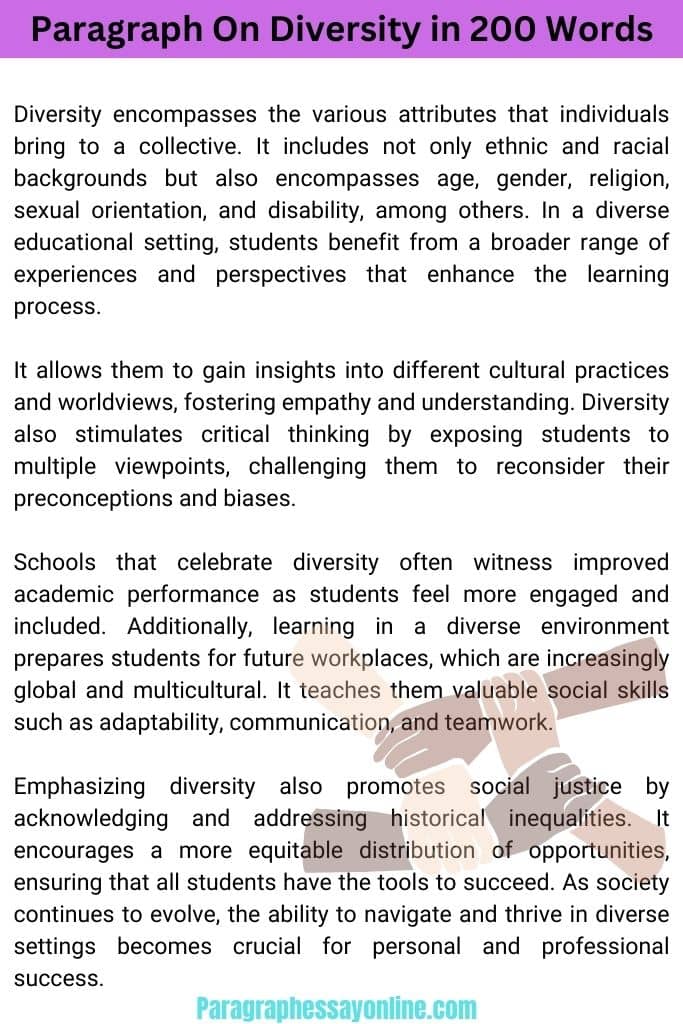Paragraph On Diversity
Paragraph On Diversity Long and Short (100-500 words)
A diversity paragraph celebrates the richness and beauty of human differences, emphasizing the importance of embracing various cultures, ethnicities, religions, and perspectives. It promotes inclusivity, mutual understanding, and respect, while acknowledging the challenges and benefits of living in a diverse society.
Diversity Paragraph 100 Words For 1, 2, 3 Students
Diversity means having many different types of people and things together. It is like a big box of crayons with lots of colors. Each color is special and makes the box better. In a diverse place, people come from different places, have different skin colors, and like different things.
They may speak different languages or celebrate different festivals. When we learn from people who are not the same as us, we get new ideas and have more fun. It’s good to have diversity because it helps us understand and care for each other better. Everyone is important, and everyone belongs.
Paragraph On Diversity in 150 Words For 4 & 5 Students
Diversity is all about having a variety of people and ideas in one place. Imagine a garden with many different flowers; each flower is unique in its color, shape, and smell. This variety makes the garden beautiful and interesting. Similarly, when people from different backgrounds, cultures, and beliefs come together, it creates a rich environment where everyone can share and learn new things.
In a diverse community, people might eat different foods, speak various languages, and celebrate unique holidays. This mix of traditions and viewpoints helps us grow and understand the world better.
Schools with students from different cultures bring diverse ways of thinking and solving problems. This helps everyone think creatively and work better together. By embracing diversity, we prepare to live and work in a world that is connected and constantly changing. Everyone has something valuable to offer, making our communities stronger and more vibrant.

Diversity Paragraph in 200 Words For 6, 7, and 8 Students
Diversity encompasses the various attributes that individuals bring to a collective. It includes not only ethnic and racial backgrounds but also encompasses age, gender, religion, sexual orientation, and disability, among others. In a diverse educational setting, students benefit from a broader range of experiences and perspectives that enhance the learning process.
It allows them to gain insights into different cultural practices and worldviews, fostering empathy and understanding. Diversity also stimulates critical thinking by exposing students to multiple viewpoints, challenging them to reconsider their preconceptions and biases.
Schools that celebrate diversity often witness improved academic performance as students feel more engaged and included. Additionally, learning in a diverse environment prepares students for future workplaces, which are increasingly global and multicultural. It teaches them valuable social skills such as adaptability, communication, and teamwork.
Emphasizing diversity also promotes social justice by acknowledging and addressing historical inequalities. It encourages a more equitable distribution of opportunities, ensuring that all students have the tools to succeed. As society continues to evolve, the ability to navigate and thrive in diverse settings becomes crucial for personal and professional success.

Paragraph On Diversity in 250 Words For 8,9,10 Students
Diversity is a fundamental aspect of our society, reflecting the complexity of the global landscape. It is not merely about recognizing differences but actively embracing and valuing them. In educational settings, diversity goes beyond having students from different backgrounds; it involves integrating these diverse experiences into the curriculum and fostering an inclusive atmosphere.
This approach encourages students to explore and respect different cultural narratives and histories, which enriches their educational experience and broadens their perspectives. Diversity in the classroom leads to richer discussions, more comprehensive understanding, and greater innovation, as students bring diverse problem-solving methods and ideas.
This diversity enriches our learning environments and workplaces by promoting creativity and innovation. In a diverse setting, students are exposed to various ways of thinking, which can enhance problem-solving skills and lead to better solutions.
Moreover, a diverse learning environment helps to dismantle stereotypes and reduce discrimination by promoting direct interaction and cooperation among various groups. It prepares students for the real world, where they will interact with a wide range of people in their personal and professional lives.
Furthermore, schools that prioritize diversity can address social inequities by providing all students with equal access to educational resources and opportunities. This commitment to diversity also fosters resilience in students, as they learn to adapt to and respect differences, which is crucial in today’s ever-changing global society. By valuing diversity, we cultivate a generation of leaders who are socially aware and committed to advocating for equity and inclusion. Such education is essential for creating a more just and inclusive world.
Paragraph On Diversity 300 Words For 9, 10, 11, 12 Students
Diversity represents the various facets of human identity that make communities unique and vibrant. It includes differences in race, ethnicity, gender, sexual orientation, socioeconomic status, language, culture, religious beliefs, and physical abilities. In educational settings, embracing diversity enriches the learning experience, promoting a broader worldview and fostering a more inclusive community.
This type of environment encourages students to develop empathy by understanding and appreciating the experiences and perspectives of others different from their own.
Diverse classrooms provide opportunities for students to engage with multiple perspectives, which enhances critical thinking and problem-solving skills. This exposure helps dismantle prejudices and reduce biases, promoting social harmony.
Moreover, learning in a diverse setting prepares students for the global workforce, where collaboration with people from varied backgrounds is the norm. Schools committed to diversity can also bridge educational gaps by providing equitable opportunities for all students, regardless of their backgrounds.
Schools and communities that prioritize diversity help cultivate a sense of belonging and acceptance, making everyone feel valued and respected. By fostering an inclusive environment, we also combat prejudice and reduce social conflicts, leading to a more harmonious society.
By promoting diversity, schools foster a sense of belonging and acceptance, creating a safe space where all students feel valued and empowered.
This inclusivity leads to higher academic engagement and success, as students feel supported and understood. Additionally, addressing diversity in education promotes social justice, helping to address and rectify historical inequalities and systemic issues. Ultimately, valuing diversity in schools shapes future leaders who are culturally competent and equipped to make positive changes in an increasingly diverse world.
Diversity Paragraph in 500 Words For 9, 10, 11, and 12 Students
Diversity is a comprehensive concept that encompasses the myriad ways individuals differ, extending beyond visible distinctions to include a range of experiences, skills, and worldviews that contribute to a rich, multifaceted community. It involves recognizing and valuing the unique contributions each person brings to the table, which in turn enhances collective creativity and problem-solving abilities.
In the context of education, embracing diversity means creating an environment where all students, regardless of their backgrounds, are given the tools and opportunities to succeed. This approach involves integrating diverse cultures, languages, and perspectives into the curriculum, which not only enhances learning but also promotes mutual respect and understanding. A diverse educational setting exposes students to a wide array of thoughts and ideas, challenging them to think critically and empathize with others. It prepares them for real-world interactions in an increasingly global society, where they will need to collaborate with people from diverse backgrounds.
Moreover, schools that prioritize diversity are better positioned to address educational disparities and promote equity. By tailoring educational approaches to meet the varied needs of students, educators can help bridge gaps in achievement and opportunity. This focus on inclusivity extends beyond the classroom, influencing broader social attitudes and helping to dismantle systemic barriers that have historically marginalized certain groups.
Diversity also plays a crucial role in fostering innovation and creativity. Students who learn to appreciate different viewpoints and collaborate across cultural lines are more likely to develop new ideas and solutions to complex problems. They are equipped to enter diverse workplaces where such skills are increasingly in demand.
Furthermore, an emphasis on diversity in schools helps to cultivate a sense of belonging and community among students. When students see their identities and experiences reflected in their education, they feel more connected and engaged. This sense of inclusion leads to better academic outcomes and higher levels of student satisfaction.
This inclusivity leads to higher academic engagement and success, as students feel supported and understood. Additionally, addressing diversity in education promotes social justice, helping to address and rectify historical inequalities and systemic issues.
Lastly, teaching diversity instills values of social responsibility and justice. Students learn to recognize inequalities and are motivated to advocate for change, both within their immediate environments and in the wider world. By learning about and valuing diversity, students are prepared to be active, compassionate citizens in a diverse society.
Prioritizing diversity in education not only enhances learning and fosters a healthy social environment but also prepares students to succeed in a diverse world. It is a vital component of comprehensive education that equips young people with the tools they need to navigate, contribute to, and enrich the global community.
Most Important Paragraph:
| Favourite Sportsman Paragraph. |
| Mango Paragraph. |
| River Paragraph. |
| Rising Pollution Paragraph. |
| My Pet Animal Paragraph. |
Frequently Asked Questions on Paragraph On Diversity
Q: What is diversity in a paragraph?
Diversity in a paragraph means talking about how people are different from each other, like their culture, beliefs, and backgrounds.
Q: Why is diversity important in writing?
Diversity is important because it helps us understand and respect others who may be different from us, making our writing more inclusive and relatable.
Q: How can I show diversity in my writing?
You can show diversity by including characters, stories, and perspectives from different cultures, races, and backgrounds in your writing.
Q: What is the benefit of talking about diversity in a paragraph?
Talking about diversity helps us learn about each other, appreciate our differences, and create a more accepting and harmonious society.
